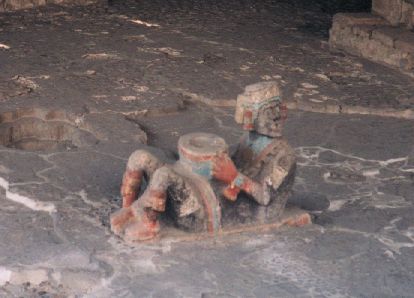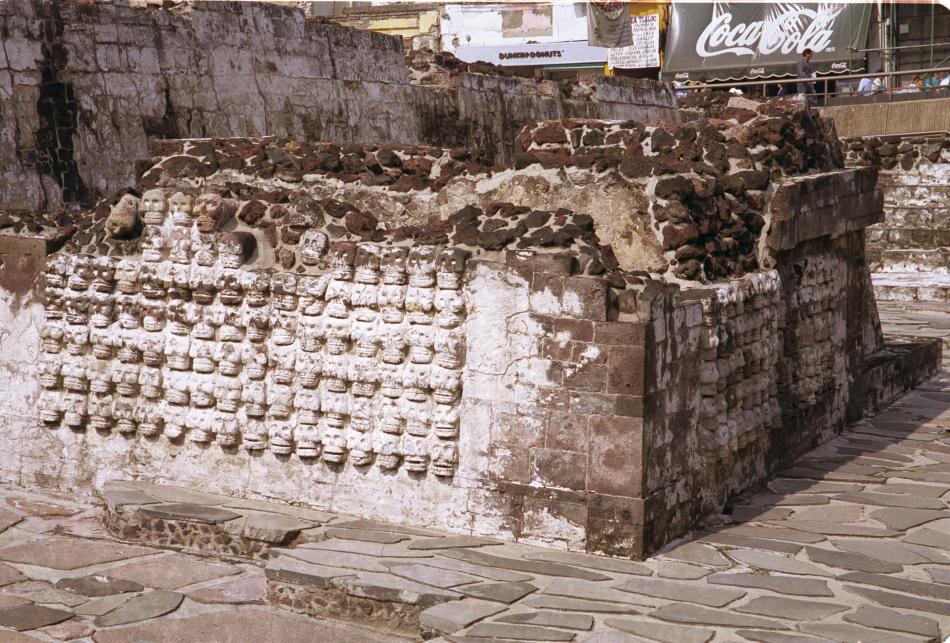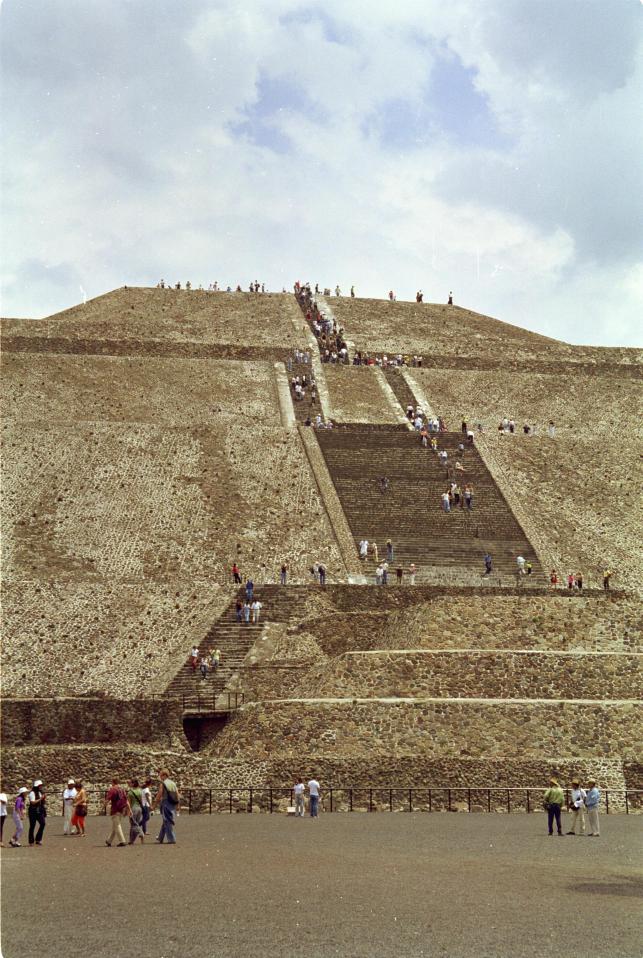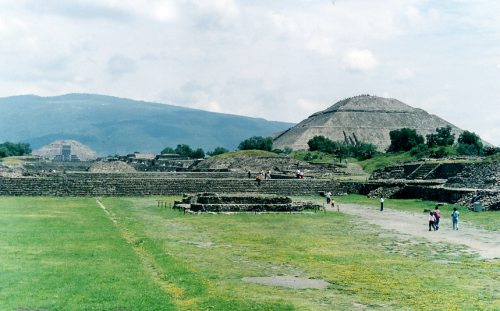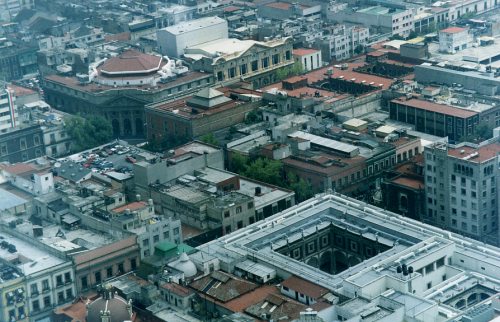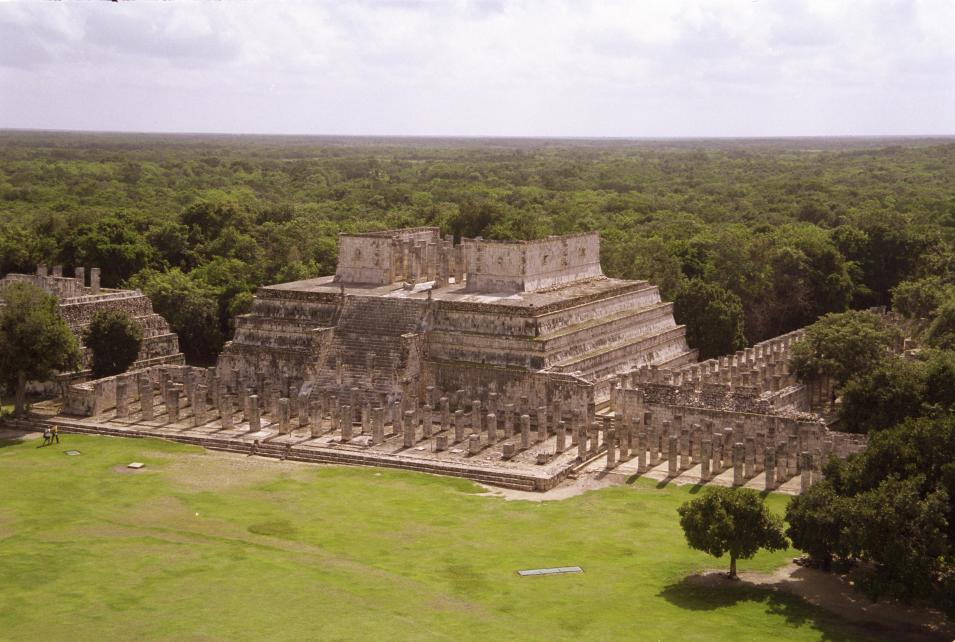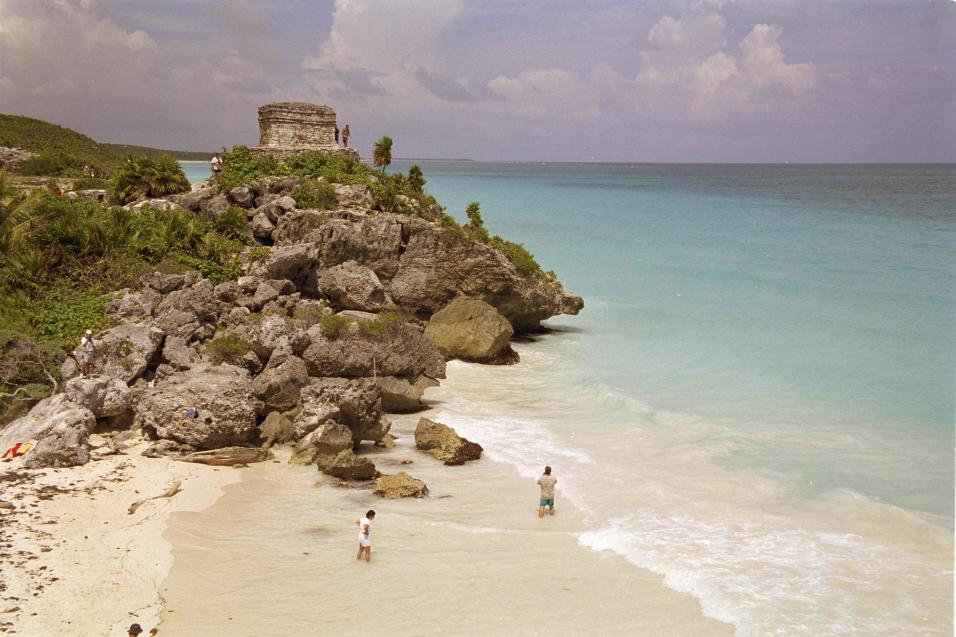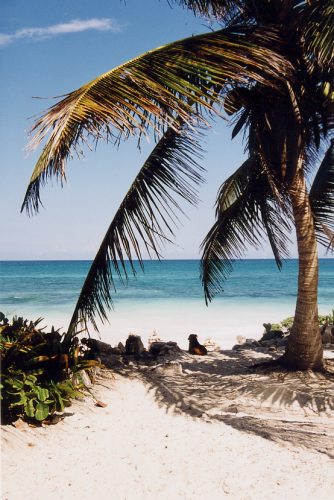Mexico
10 September 2002: Mexico City, Mexico
Greetings from Mexico! I´ve been in Mexico City for
nearly a week and tomorrow I´m flying to Campeche, up in the
Yucatan peninsular. So here are a few words about what I´ve
been up to here.
Mexico City - First Impressions
What are your preconceptions about this enormous city?
Air pollution, crime, poverty? Well none of those have
particularly struck me. True I did go up to the 42nd floor
of the Torre Latinamerican and you couldn´t see very far from
the top, but how many people have had no view from the Eiffel
Tower or the London Eye? And there are certainly no more
beggars here than you would find in London or Manchester.
In all it´s a very bustling place with things going on all
the time.
The place is crawling with police. I mean literally
dozens on each street corner, with different coloured
uniforms with different amounts of braid and many of them
heavily armed. I don´t know if this is normal, but it
just makes me think "if each of those salaries could be
going to a teacher or a doctoer".
I´ve been lucky to come when I have. The 15th September
is Independence Day, and they´ve been having an extended fiesta
for a week already. I´m staying right next to the Zocalo,
the main square in the historic centre, and on Saturday
night they had Mexico´s answer to Frank Sinatra (or maybe
Tom Jones) crooning away all evening. During the day the square
is full of stalls, including huge marquees full of handicrafts.
Quite a spectacle.
History (Ancient)
Most of the obvious things-to-see here are the
pre-conquest archaeological remains. I took a bus out to
Teotihuacan (quite an adventure in itself - but at least there
is a bus); this is the famous place with pyramids built by
the Aztecs (or should that be the Mexaca - not too sure about
those two). Very impressive, but infuriatingly full of hawkers
trying to sell plastic pyramids and similar tat. Also, I
realised after a while that it had all been quite substantially
reconstructed in the early 1900s. They don't make that very
clear - but today I went to the national art museum and a 19th
century painting of the site that made it quite clear how much
it had been restored. They now think that the restoration
added one more step to the pyramid than it should have had!
Teotihuacan is about 40km from the city centre and was
relatively undamaged during the conquest. But a similar
temple complex existed here in what is now the centre of Mexico
City, and that got flattened (and much of the stone used to
build the impressive and wobbly cathedral). They started digging
it up in 1978, and thanks to the conquistador´s flattening the
seven stages of construction have been revealed - periodically
they built a new pyramid and temple over the top of the old one,
and the altar of the bottom one is now visible. Very impressive,
though it helps to see the cut-away model in the museum before
looking at the rocks! These pictures are of a "Chac-Mool" figure
(their rain god) on the exposed bottom-layer altar, and a stone
thing with skulls carved in it; it would have had the real skulls
of their sacrificial victims stacked on top.
History (modern)
So for a bit of variety I went to see Trotsky´s house,
where he lived in exile in the late thirties and early forties,
until he was assasinated (Stalin had condemened him to death
in abcentia). Having just read Animal Farm it was all very
fresh in my mind! It's a fascinating little place, and quite
an oasis of calm in this very busy city: I saw my first
humming-bird among the flowers.
Trotsky was invited to Mexico by a group of left-wing
artists including Diego Rivera and Frida Kahlo. Rivera is
famous for his huge murals, and it was worth the security
checks getting into the presidential palace to see his work
there. He painted a huge wall above a staircase depicting
the history of Mexico, and some smaller pieces including
"what the Mexicans have given the world" (Chillies, rubber
etc.). There are some pics at
http://www.diegorivera.com/murals/ but they
look more impressive full-size.
14 September 2002: Mérida, Yucatán, Mexico
Just time for a quick update. Here's a
of the area.
Campeche
The Yucatan peninsular is divided into three states,
Campeche, Yucatan and Quintana Roo. Campeche is on the left;
I flew there from Mexico City and will be flying on to Costa Rica
from Cancún on the opposite coast. I've got about a week to
cross the peninsular.
The town of Capeache, capital of the state, was founded by
the Spanish settlers on the site of a Mayan town. It was their
main port on the peninsular and the place through which much of
their plundered riches left the country. This drew the attention
of the Caribean pirates, including I think Francis Drake (he has
a restraunt named after him, so I have put 1 and 0 together and made
10...). Anyway the place got ransacked quite horribly and
eventually they put up a wall, parts of which still stand, along
with the defensive bastions at the corners. It is historic
enough to be listed by UNESCO as a world heritage site (their list
makes a great way to choose your holiday destinations) and they
have put some effort into making it appeal to the tourist trade.
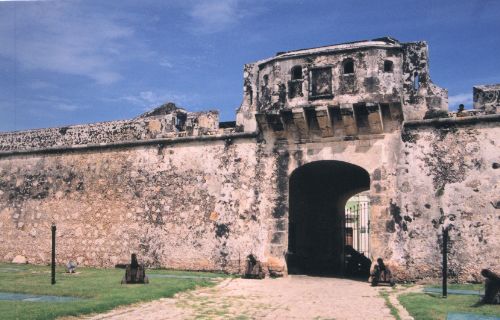
I was there for just a day, but it was enough to at
least see the difference from Mexico City. One of the first things
that I noticed was that it wasn't crawling with police, and the few
I did see were wearing shorts and riding bikes! Very Californian,
I thought to myself. Then there's the weather; Mexico City was
hot and it rained every afternoon (some of you will remember that I
bought myself a new pair of shoes before I left with some orange
bits on - well thanks to one especially torrential downpour I now
have bright orange patches on one pair of socks!). On the way
to Campeche I watched a thunderstorm out of the window of the
plane, which was quite an experience. Anyway, having come down
from 2000m to sea level, it is a bit hotter, but still essentially
the same - hot, and rain every afternoon.
Noise
I would like to say that small-town Campeche was more quiet and
laid-back than Mexico City was, but I don't think that's true. They
make up for the fact that it is smaller by creating more noise. I
think the Mexicans like noise. On the first-class buses, for example,
they show a video, and the volume is so loud I'll be taking ear plugs
next time. And practically every cafe have a TV or radio blaring
out. But worst of all, in Celestun, one of the bastions in the
old wall has been turned into a walled garden, full of palms and
other interesting tropical plants. It should be an oasis of
tranquility, but to ensure that it isn't they have a radio to fill
it with noise!
First major screw-up
Leaving Campeche to come to Mérida I made my first major screw-up
of the trip, for which I blame the Spanish and the Mexicans for not
speaking the same language (no, it can't possibly be my fault!). I
went to the bus terminal at about noon and asked for a ticket on the
next bus to Mérida, and was told that it was at "dos y treinta" (that's
"two and thirty"). "How strange", I though to myself, "why is she
converting from 24- to 12-hour clock? Maybe she thinks I'm an
American!" (Note how I try to further displace the blame from
my own shoulders at this point...). So I spent the next couple of
hours waiting, having my lunch and so on. Then when I tried to
check in my luggage my mistake was uncovered. Plainly printed on
the ticket it said "1230". How did I misunderstand that? Well "1230"
is "doce treinta", which in spain would be pronounced "dothay traynta",
quite distinct from "dos y treinta". But over here the C is pronounced
like an english S, not as a lisped TH, so it comes out as
"dosay treinta": to my ear, practically the same as "dos y treinta".
Well, I got here in the end - and they kindly refunded half the cost
of the unused ticket.
Celestún
Yesterday I went from Mérida back to the coast at a place called
Celestún, known for its flamingoes. Here's a
. Unfortunately this isn't
really the right time of year to see thousands of flamingoes, but the
boat trip is still worthwhile and we did get to see a few dozen bright
pink ones. They take you out on eight-seater boats with huge outboard
motors that whizz you along at quite a rate - they have to, as the
interesting places are quite a way away. It's not like Poole Harbour
bird boats that's for sure. Anyway they take you down the coast and
then turn, practically doubling-back, into a mangrove-lined estuary.
The mangroves are fascinating, looking like trees whose roots have
been exposed. We stopped at one point to go ashore and see some
petrified trees that were killed off 120 years ago when their roots
became innundated by salt water; but more interesting than the trees
were the crabs (the sort with huge claws - what are they called?) living
down holes all over the place. Then we stopped again at a point where
fresh water whells up from a cave; practically the whole of the
peninsular is limestone and it's full of caves. On the way back we
saw another fresh-water spring which, like something out of a
pirate story (or, dare I say it, Enid Blyton) was out in the
estuary and had been built up from the sea bed in a kind of stone
well, so that the fresh water could be collected by passing boats.
After the boat trip I had a swim and the water there in the
Gulf of Mexico was unbelievably hot - almost too hot! And the
beach was white sand and millions of shells. All in all an
excellent way to spend the day.
Next...
Now I'm back in Mérida, and will be leaving this afternoon to go
to Valadolid, East of here. From there I plan to visit Chichen Itza, the
most famous Mayan site, and hopefully some of the show caves. More news
soon!
20 September 2002: San Jose, Costa Rica
I've now arrived in Costa Rica, and it's time to write up
my final comments about Mexico.
Update: it looks as if I left just in time, as a hurricane
has hit the very area that I was staying in. Here's the BBC News
coverage:
http://news.bbc.co.uk/1/hi/world/americas/2275002.stm
Valladolid
I spent a couple of nights in Valladolid, a smallish town
in the middle of the Yucatan peninsular close to the famous Mayan
ruins at Chichen Itza. It has a pleasant hostel with a nice
garden and hammocks to laze in (with raido of course - but not
too loud). And it has caves!
Chichen Itza
Chichen Itza was an important Mayan site, complete with
pyramid-shaped temples. It's a bit better preserved than
Teotihuacan with the temples on top of the pyramids intact -
perhaps because the rock is more substantial than the light
volcanic stuff there. It also has a well-preserved ball
court where they played their ritual ball game, with stone
hoops to get the ball through in the walls, a steam bath,
and lots of stone columns.
For me the most striking difference from Teotihuacan
was the refreshing absence here of hawkers trying to sell
things - excellent.
The whole Yucatan peninsular is limestone and there are
caves everywhere. In most cases, because the land is flat and
the water table is relatively high, the caves are just holes
with water in the bottom - "cenotes". These things obviously
interested the Mayans a lot, probably related to their rain
god, and Chichen Itza has a sacred cenote. It's a big
vertical-sided hole in the ground whose sides are scoured
almost as if it had once had a giant whirlpool in it. At
the bottom is a pea-soup-green lake. Aparently messages
to the gods could be sent via this portal by dispatching a
messenger with rocks tied to his feet. The bottom has been
dredged and lots of bones and other artifacts found.
Independence Day
September 15th is Mexico's independence day, which is
celebrated with a public holiday and public fiestas. Valladolid's
central square rocked to the sounds of a pretty decent local
band, and the other Europeans from the hostel and I got a fair
bit of attention from the crows as we boogied away. Then they
elected Señorita Valladolid 2002, someone read the Act of
Independence of 1830, and we got a speach which I didn't really
follow apart from "¡Viva Mexico!". Then they poured bits of
crepe paper from the top of the town hall in the colours of the
mexican flag, and launched fireworks, which looked excellent
from our very close vantage point. Quite a party!
More Cenotes
The following morning a couple of us hired bikes to cycle
out to a couple of cenotes about 7km away. These were
mostly-enclosed caverns, with rays of sunlight and tree roots
coming in through holes in the roofs. In the first we swam
and floated around on car tyres. In the second, which was
cheaper yet more impressive, we were just looking around and
taking some photos when a flock of local kids swarmed down the
slippery steps behind us and plunged from a great height into
the water, splashing down like bombs. Then we watched with
horror as they found higher and higher ledges to scrabble up
to and dive from. I wondered if we were about to observe
Natural Selection in action. (I think they were speaking
Mayan, making this the only time I actually heard anything
other than Spanish. At the archaeological sites, the information
panels were all in Spanish, the native language (Nauatl around
Mexico City and Mayan in Yucatan), and English.)
Tulum
From Valladolid I took a bus to the East coast of the
peninsular at Tulum, on Mexico's Caribean coast or the
Riviera Maya as they like to call it. Further north,
resorts like Cancun are highly developed with big luxury
hotels, but Tulum has more rustic places to stay - mostly
thatched cabins amongst the palms. I arrived with another
English traveller from Valladolid and we had both bought
hammocks that we wanted to try out (Yucatan is considered
the world's best hammock-producing area), and we
spent a couple of nights with our hammocks suspended between
cocnut palms. It was perfectly comfortable, apart from the
insects.
The beach is excellent, and not at all busy, though unlike
Celestun on the other coast it didn't have many shells and I
think the water was possibly a bit cooler too. But the thing
that distinguishes Tulum from any other bit of beach is the
Mayan ruins overlooking the beaches. The Mayans built a
port-town here, with a defensive wall on three inland sides
and cliff-top temples and defensive structures. Very
picturesque, and a great place to end my stay.
15 October 2002: San José, Costa Rica
Photos!
Dad has kindly scanned in some of the Mexico photos that I
posted home. Here they are.
The first couple are from Teotihuacan, the Aztec / Mexicana site
outside Mexico city. This is the Pyramid of the Sun:
And this is a more general view looking up the Avenue of the Dead with the Pyramid of the Sun to the right.
This is a view from the top of the Torre Latinamericano, one of
Mexico City's tallest buildings. As you can see it is quite hazy.
At the bottom right you can see a building with an inner courtyard,
in a vaguely southern-spanish style. The building with the columns
on the front at the top left is I think the mexico city assembly.
This is Celestún, from where I took the boat trip to
see the flamingoes. The beach was covered in shells. This place
must have suffered quite badly in the hurricane a few weeks
later.
This is Chichen Itza, the Mayan site in Yucatan, showing one of the
temples (note how here the temple itself on the top of the pyramid is
preserved, whereas at Teotihuacan the tops of the
pyramids are bare), surrounded by the Colonade of the Thousand
Columns, or whatever they called it. This is taken from the top of
the main pyramid.
This is Tullum, the beachside Mayan place near where I
stayed for my last few days in Mexico.
This is where I stayed in Tullum.
© 2002 - 2003
